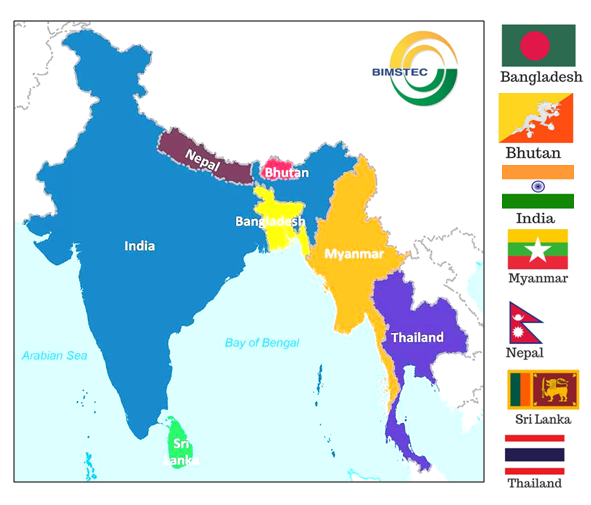BIMSTEC and India
About BIMSTEC:

- The Bay of Bengal Initiative for Multi-Sectoral Technical and Economic Cooperation (BIMSTEC) is a regional organisation that was established on 06 June 1997 with the signing of the Bangkok Declaration.
- Initially known as BIST-EC (Bangladesh-India-Sri Lanka-Thailand Economic Cooperation), the organisation is now known as BIMSTEC and comprises seven Member States with the admission of Myanmar on 22 December 1997, and Bhutan and Nepal in February 2004.
- The main aim of the regional group was the promotion of economic cooperation between countries bordering the Bay of Bengal.
- BIMSTEC is a five-tiered organisation:
- The Summit comprising the Heads of State or Government of the Member States
- The Ministerial Meeting comprising the Ministers dealing with foreign relations of the Member States
- The Sectoral Ministerial Meetings comprising the Ministers of line ministries responsible for carrying out the activities of the respective sectors
- The Senior Officials’ Meeting consisting of the Foreign Secretaries/ Secretaries/ appropriate Senior officials nominated by the BIMSTEC Member States
- The BIMSTEC Permanent Working Committee (BPWC) comprises senior officials of the respective National Focal Points.
- National Focal Points (NFP) are established within the Ministries of External/ Foreign Affairs/ Foreign Relations of each Member State to serve as the points of contact for all BIMSTEC related communications and coordination between the BIMSTEC Secretariat and Member States.
Significance of BIMSTEC for India:
- Enhanced Regional Connectivity: BIMSTEC connects South Asia and Southeast Asia, facilitating better trade, investment, and infrastructure development. This connectivity is vital for India’s economic integration with neighbouring regions and enhances access to markets.
- Countering China’s Influence: The Bay of Bengal is strategically crucial, especially with China’s Belt and Road Initiative (BRI) expanding in the region. BIMSTEC offers India a platform to promote alternative connectivity and infrastructure projects, adhering to international norms and standards.
- Economic and Sustainable Development: BIMSTEC focuses on areas such as trade, investment, connectivity, energy, counter-terrorism, and the Blue Economy. This collaboration supports India’s economic and developmental goals, leveraging shared regional resources and expertise.
- Strategic Alternative to SAARC: BIMSTEC provides India with a platform to engage with regional neighbours without the obstructionist role of Pakistan, which has been a hindrance in SAARC. This is particularly important after India’s efforts to isolate Pakistan following the 2016 Uri attack.
- Support for India’s Foreign Policy Goals: BIMSTEC aligns with India’s strategic policies on regional engagement and cooperation. It helps India strengthen ties with its eastern neighbours and engage more with Southeast Asia, complementing its broader foreign policy objectives.
- BIMSTEC provides a framework for India to promote peace and stability in the region, countering security threats like terrorism and organised crime. It also offers a venue for discussing non-traditional security challenges, including maritime security and disaster management.
- Historical and Cultural Ties: BIMSTEC nations share historical and cultural connections, which the organisation aims to develop on. This aspect helps strengthen cultural diplomacy and people-to-people ties, supporting India’s soft power in the region.
- Building Institutional Mechanisms: Through regular summits and meetings, BIMSTEC aims to develop robust institutional mechanisms for cooperation. This helps India and other member states coordinate policies and initiatives more effectively.
Way forward:
- This year marks a decade of India’s Act East and Neighbourhood First policies, and the thrust on BIMSTEC is a manifestation of New Delhi’s efforts to continue supporting collaborative growth for national and regional well-being.
- Forthcoming Summit of BIMSTEC has the potential to push forth a bold vision for the region’s economical, technological and social growth.
Subscribe
Login
0 Comments
